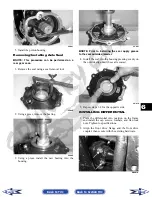
5-13
5
Fuel Solenoid
The fuel solenoid is used in conjunction with the igni-
tion switch to control fuel flow from the lift pump to
the unit injectors. This enables the operator to shut off
the engine quickly using the emergency stop switch or
the ignition switch. To test the fuel solenoid, use the
following procedure.
1. On a suitable multimeter, place the switch in the
DC Volts position; then connect the black tester
lead to a suitable ground and the red tester lead to
the fuel solenoid terminal.
DE647B
2. With the engine stop switch in the RUN position,
turn the ignition switch to the ON position. The
meter should read battery voltage and an audible
“click” should be heard from the fuel solenoid.
3. If no voltage is present, check the 15 amp ignition
fuse, the ignition switch, or system wiring. If volt-
age is present, replace the fuel solenoid (see Sec-
tion 4).
Troubleshooting
Problem: Charging unstable
Condition
Remedy
1.
Battery connections
loose or corroded
2.
Alternator belt
loose
3.
Alternator/regulator
failing
1. Clean and tighten connections
2. Tighten - replace belt
3. Replace alternator assembly
Problem: Starter button not effective
Condition
Remedy
1.
Battery charge
low
2.
Switch contacts
defective
3.
Starter solenoid
defective
4.
Starter relay
defective
5.
Emergency stop - ignition switch
off
6.
Wiring connections
loose - disconnected
1. Charge - replace battery
2. Replace switch
3. Replace starter assembly
4. Replace relay
5. Turn on switches
6. Connect - tighten - repair connections
Problem: Battery discharges too rapidly
Condition
Remedy
1.
Battery
sulfided
2.
Electrical system
excessively loaded
3.
Charging system
not charging
1. Replace battery
2. Reduce load
3. Replace alternator - tighten alternator belt
Problem: Battery polarity reversed
Condition
Remedy
1.
Battery
incorrectly connected
1. Reverse connections - replace battery - repair damage
Back to TOC
Back to Section TOC
Back















































